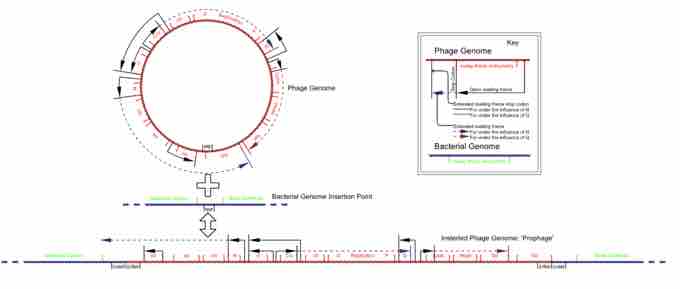In virology, temperate refers to the ability of some bacteriophages (notable coliphage λ) to display a lysogenic life cycle. Many (but not all) temperate phages can integrate their genomes into their host bacterium's chromosome, together becoming a lysogen as the phage genome becomes a prophage. A temperate phage is also able to undergo a productive, typically-lytic life cycle, where the prophage is expressed, replicates the phage genome, and produces phage progeny, which then leave the bacterium. With phage the term virulent is often used as an antonym to temperate, but more strictly a virulent phage is one that has lost its ability to display lysogeny through mutation, rather than a phage lineage with no genetic potential to ever display lysogeny (which more properly would be described as an obligately lytic phage).
P1 is a temperate bacteriophage (phage) that infects Escherichia coli and some other bacteria. When undergoing a lysogenic cycle, the phage genome exists as a plasmid in the bacterium, unlike other phages (e.g., the lambda phage) that integrate into the host DNA. P1 has an icosahedral "head" containing the DNA, attached to a contractile tail with six tail fibers.
The virion is similar in structure to the T4 phage, but simpler. It has an icosahedral head containing the genome attached at one vertex to the tail. The tail has a tube surrounded by a contractile sheath, and ends in a base plate with six tail fibers. The tail fibers are involved in attaching to the host and providing specificity.
At around 93Kbp in length, the genome of the P1 phage is moderately large compared to the genomes of others, like T4 (169Kbp), lambda (48Kbp), and Ff (6.4Kbp). In the viral particle it is in the form of a linear double-stranded DNA molecule. Once inserted into the host, it circularizes and replicates as a plasmid.
Temperate phage, such as P1, have the ability to exist within the bacterial cell they infect in two different ways. In lysogeny, P1 can exist within a bacterial cell as a circular DNA, in that it exists by replicating as if it were a plasmid and does not cause cell death. Alternatively, in its lytic phase, P1 can promote cell lysis during growth, resulting in host cell death. During lysogeny, new phage particles are not produced. In contrast, during lytic growth many new phage particles are assembled and released from the cell. By alternating between these two modes of infection, P1 can survive during extreme nutritional conditions that may be imposed upon the bacterial host in which it exists.
A unique feature of phage P1 is that during lysogeny its genome is not incorporated into the bacterial chromosome, as is commonly observed during lysogeny of other bacteriophage. Instead, P1 exists independently within the bacterial cell, much like a plasmid would. P1 replicates as a 90 kilobase (kb) plasmid in the lysogenic state and is partitioned equally into two new daughter cells during normal cell division.
Enterobacteria phage λ (lambda phage, coliphage λ) is a bacterial virus, or bacteriophage, that infects the bacterial species Escherichia coli. This virus is temperate and may reside within the genome of its host through lysogeny.
Lambda phage consists of a virus particle including a head (also known as a capsid), a tail, and tail fibers. The head contains the phage's double-stranded circular DNA genome. The phage particle recognizes and binds to its host, E. coli, causing DNA in the head of the phage to be ejected through the tail into the cytoplasm of the bacterial cell . Usually, a "lytic cycle" ensues, where the lambda DNA is replicated many times and the genes for head, tail, and lysis proteins are expressed. This leads to assembly of multiple new phage particles within the cell and subsequent cell lysis, releasing the cell contents, including virions that have been assembled, into the environment. However, under certain conditions the phage DNA may integrate itself into the host cell chromosome in the lysogenic pathway. In this state, the λ DNA is called a prophage and stays resident within the host's genome without apparent harm to the host. The host can be termed a lysogen when a prophage is present.

Insertion of the bacteriophage lambda
Schematic representation of the insertion of the bacteriophage lambda. Note how sib is displaced by the recombination event from the N extended PL promoter open reading frame.
The virus particle consists of a head and a tail that can have tail fibers. The head contains 48,490 base pairs of double-stranded, linear DNA, with 12-base single-stranded segments at both 5' ends. These two single-stranded segments are the "sticky ends" of what is called the cos site. The cos site circularizes the DNA in the host cytoplasm. In its circular form, the phage genome therefore is 48,502 base pairs in length. The prophage exists as a linear section of DNA inserted into the host chromosome.